Impact of KNO3-Based Salt Nitriding Treatment on the Microstructure and Corrosion Resistance of Steel 20MnCr5 †
Abstract
:1. Introduction
2. Materials and Experimental Procedure
2.1. Materials
2.2. Nitriding in Non-Toxic Salt Bath
2.3. Materials Characterization
2.4. Electrochemical Investigations
3. Results and Discussion
3.1. Microstructure and Morphology
3.2. Phase Analysis
3.3. Hardness Measurements
3.4. Electrochemical Analysis
3.4.1. Open Circuit Potential (OCP)
3.4.2. Linear Polarization Resistance (LPR)
3.4.3. Electrochemical Impedance Spectroscopy (EIS)
3.4.4. Potentiodynamic Polarization
4. Conclusions
- A diffusion zone of varying thickness was observed extending to a maximum depth of 70 μm throughout the sample. Although it was continuous in most areas, localized thinning or complete absence of the zone was observed in certain areas. The treated surface exhibits roughness, where defects such as pores and microcracks may be present.
- X-ray diffraction analysis showed no detectable ε-Fe2-3N, γ’-Fe4N, or CrN phases, suggesting that nitrogen primarily occupies interstitial sites within the α-Fe lattice. This interstitial solid solution caused a measurable lattice expansion of 0.16%, confirming the effective dissolution and diffusion of nitrogen into the ferritic matrix material. The absence of distinct nitride phases suggests a diffusion-controlled mechanism driven by solid solution strengthening rather than compound layer formation.
- The nanoindentation measurements revealed an 80% increase in surface hardness (10.2 GPa compared to 5.67 GPa in the substrate), which can be attributed to a mechanism of solid-state solidification by nitrogen interstitials. The Young’s modulus anomaly, i.e., a counterintuitive 18% reduction in Young’s modulus near the surface, was observed, which is likely due to nitrogen-induced lattice distortions, defect proliferation, and possible residual stresses that have disturbed the conventional hardness–stiffness relationship.
- Improved corrosion performance: Despite a cathodic shift in corrosion potential (indicating greater thermodynamic susceptibility), the nitrided layer showed a 58% lower corrosion rate (1.275 mm/year) compared to untreated steel (3.04 mm/year) in 3.5% NaCl. This improvement is attributed to the nitrided layer acting as a partial barrier against chloride ingress, although corrosion is localized at microstructural defects (e.g., pores and microcracks), resulting in lower polarization resistance but lower overall corrosion current density.
- Environmental and practical impact: The KNO3-based nitriding process has been demonstrated to be a non-toxic, environmentally friendly alternative to conventional cyanide-based nitriding processes, with high surface hardness and excellent corrosion resistance. Although the process has a high industrial profitability, further optimization of critical parameters such as temperature and treatment time is required to reduce surface defects (e.g., porosity, microcracks, thickness, etc.) and improve corrosion resistance for large components.
Author Contributions
Funding
Institutional Review Board Statement
Informed Consent Statement
Data Availability Statement
Acknowledgments
Conflicts of Interest
References
- Mittemeijer, E.J.; Somers, M.A.J. Thermochemical Surface Engineering of Steels, 1st ed.; Woodhead Publishing: Cambridge, UK, 2015; pp. 1–10. [Google Scholar]
- Fonović, M. Nitriding Behaviour of Ni and Ni-Based Binary Alloys. Ph.D. Thesis, University of Stuttgart, Stuttgart, Germany, 20 January 2015. Available online: https://elib.uni-stuttgart.de/opus/volltexte/2015/9830/ (accessed on 29 January 2025).
- Mittemeijer, E.J. Nitriding and Nitrocarburizing of Steels. In ASM Handbook: Steel Heat Treating Fundamentals and Processes, 1st ed.; Dossett, J., Totten, G.E., Eds.; ASM International: Novelty, OH, USA, 2013; Volume 4A, pp. 617–641. [Google Scholar]
- Dong, H. S-phase surface engineering of Fe-Cr, Co-Cr and Ni-Cr alloys. Int. Mater. Rev. 2010, 55, 25–98. [Google Scholar] [CrossRef]
- Funatani, K. Low-Temperature Salt Bath Nitriding of Steels. Heat Treat. Met. 2004, 46, 277–281. [Google Scholar] [CrossRef]
- Huzar, T.F.; George, T.; Cross, J.M. Carbon monoxide and cyanide toxicity: Etiology, pathophysiology and treatment in inhalation injury. Expert Rev. Respir. Med. 2013, 7, 159–170. [Google Scholar] [CrossRef]
- Bell, T.; Dearnley, A. Environmental issues in surface engineering and related industrial sectors. Surf. Eng. 1994, 10, 123–128. [Google Scholar] [CrossRef]
- Shen, Y.Z.; Oh, K.H.; Lee, D.N. Nitriding of Interstitial Free Steel in Potassium–Nitrate Salt Bath. ISIJ Int. 2006, 46, 111–120. [Google Scholar] [CrossRef]
- Hamdy, A.S.; Marx, B.; Butt, D. Electrochemical studies on the film formed by direct nitridation of AA2024 in a KNO3 salt bath at low temperature. Mater. Chem. Phys. 2011, 127, 253–258. [Google Scholar] [CrossRef]
- Shen, Y.Z.; Oh, K.H.; Lee, D.N. Nitriding of steel in potassium nitrate salt bath. Scr. Mater. 2005, 53, 1345–1349. [Google Scholar] [CrossRef]
- Bonow, V.T.; Maciel, D.S.; Fenner, N.L.; Reguly, A.; Zimmer, A.; Zimmer, C.G. Nitriding in non-toxic salts bath: An approach to implement cleaner production in the metallurgic industry. Clean. Eng. Technol. 2021, 4, 100169. [Google Scholar] [CrossRef]
- Bonow, V.T.; Maciel, D.S.; Zimmer, A.; Zimmer, C.G. Nitriding in low carbon steels using non-toxic salt baths. Rev. Lib. 2019, 20, 177–186. [Google Scholar] [CrossRef]
- Lee, T.H.; Oh, C.S.; Lee, M.K.; Han, S.W. Nitride precipitation in salt-bath nitrided interstitial-free steel. Mater. Charact. 2010, 61, 975–981. [Google Scholar] [CrossRef]
- Zhu, Y.S.; Wei, X.N.; Yin, Y.X. A novel low temperature and green salt bath nitriding of titanium alloy. Surf. Eng. 2021, 37, 1422–1431. [Google Scholar] [CrossRef]
- Roy, A.; Shiva Kumar, K.; Raghunath, A.; Sharma, R.C.; Shekhar, R. Feasibility and kinetics of nitriding of pure titanium and Ti–6Al–4V in molten salt bath of potassium nitrate. Surf. Eng. 2012, 28, 458–463. [Google Scholar] [CrossRef]
- Sabuz, E.H.; Maruf, M.A.; Haider, W.; Shabib, I. Enhanced Corrosion Resistance of TiZrN-Coated Additively Manufactured 8620 Low-Alloy Steel in Nitrate Salt Solution and Salt Bath. Coatings 2023, 13, 1998. [Google Scholar] [CrossRef]
- Freeman, E.S. The Kinetics of the Thermal Decomposition of Potassium Nitrate and of the Reaction between Potassium Nitrite and Oxygen. J. Am. Chem. Soc. 1957, 79, 838–842. [Google Scholar] [CrossRef]
- Stern, K.H. High Temperature Properties and Decomposition of Inorganic Salts Part 3, Nitrates and Nitrites. J. Phys. Chem. Ref. Data 1972, 1, 747–772. [Google Scholar] [CrossRef]
- Stein, J.; Schacherl, R.E.; Jung, M.; Meka, S.; Rheingans, B.; Mittemeijer, E.J. Solubility of nitrogen in ferrite; the Fe–N phase diagram. Int. J. Mater. Res. 2013, 104, 1053–1065. [Google Scholar] [CrossRef]
- Mittemeijer, E.J.; Somers, M.A.J. Thermodynamics, kinetics, and process control of nitriding. Surf. Eng. 1997, 13, 483–497. [Google Scholar] [CrossRef]
- Wang, C.; Xu, S.; Li, W.; Wang, Y.; Shen, G.; Wang, S. Multi-physics coupled simulation and experimental investigation of alternating stray current corrosion of buried gas pipeline adjacent to rail transit system. Mater. Des. 2024, 247, 113394. [Google Scholar] [CrossRef]
- Wang, C.; Li, W.; Wang, Y.; Yang, X.; Xu, S. Predictive model for corrosion hazard of buried metallic structure caused by stray current in the subway. Anti-Corros. Methods Mater. 2019, 66, 486–495. [Google Scholar] [CrossRef]
- Brnic, J.; Turkalj, G.; Lanc, D.; Canadija, M.; Brcic, M.; Vukelic, G. Comparison of material properties: Steel 20MnCr5 and similar steels. J. Constr. Steel Res. 2015, 95, 81–89. [Google Scholar] [CrossRef]
- Lee, M.K.; Kim, D.S.; Kim, S.C.; Han, S.W.; Kim, I.; Lee, D.N. Effect of NaCl and CaCl2 additives on NaNO3 bath nitriding of steel. Mater. Sci. Eng. A 2010, 527, 1048–1051. [Google Scholar] [CrossRef]
- The International Centre for Diffraction Data. Available online: https://www.icdd.com/ (accessed on 15 January 2025).
- Riester, L.; Bridge, R.J.; Breder, K. Characterization of Vickers, Berkovich, Spherical and Cube Cornered Diamond Indenters by Nanoindentation and SFM. Mater. Res. Soc. Symp. Proc. 1998, 522, 45–50. [Google Scholar] [CrossRef]
- Oliver, W.C.; Pharr, G.M. An improved technique for determining hardness and elastic modulus using load and displacement sensing indentation experiments. J. Mater. Res. 1992, 7, 1564–1583. [Google Scholar] [CrossRef]
- Gamry Instruments. Getting Started with Electrochemical Corrosion Measurement. Gamry Instruments, Inc. Available online: https://www.gamry.com/assets/Application-Notes/Getting-Started-with-Electrochemical-Corrosion-Measurement.pdf (accessed on 19 January 2025).
- Gamry Instruments. Basics of Electrochemical Impedance Spectroscopy. Gamry Instruments, Inc. Available online: https://www.gamry.com/application-notes/EIS/basics-of-electrochemical-impedance-spectroscopy/ (accessed on 24 January 2025).
- Shi, P.; Leng, B.; Ye, X.; Wang, S.; Chang, L.; Li, X.; Li, X.; Huang, H. Tribological behavior of 316H stainless steel in NaNO3-KNO3 molten salt at elevated temperature. Sol. Energy Mater. Sol. Cells 2023, 257, 112377. [Google Scholar] [CrossRef]
- Fonović, M.; Kvrgić, D.; Iljkić, D.; Liverić, L. Gaseous nitriding of pure nickel—Observation and interpretation of microstructural features. In Proceedings of the 12th International Conference Mechanical Technologies and Structural Materials, Split, Croatia, 21–22 September 2023. [Google Scholar]
- Nakada, N.; Tsuboi, K.; Onomoto, T.; Tsuchiyama, T.; Takaki, S.; Inden, G. Thermodynamics and kinetics of solution nitriding. Calphad 2014, 47, 168–173. [Google Scholar] [CrossRef]
- Fonović, M.; Liverić, L.; Pavlović, L.; Jurković, Z. Nitriding of steel 20MnCr5 using an environmentally friendly salt. In Proceedings of the 13th International Conference Mechanical Technologies and Structural Materials, Split, Croatia, 19–20 September 2024. [Google Scholar]
- Cheng, Y.T.; Cheng, C.M. Relationships between hardness, elastic modulus, and the work of indentation. Appl. Phys. Lett. 1998, 73, 614–616. [Google Scholar] [CrossRef]
- Tromas, C.; Stinville, J.C.; Templier, C.; Villechaise, P. Hardness and elastic modulus gradients in plasma-nitrided 316L polycrystalline stainless steel investigated by nanoindentation tomography. Acta Mater. 2012, 60, 1965–1973. [Google Scholar] [CrossRef]
- Kharouji, H.; Dezerald, L.; Hirel, P.; Carrez, P.; Cordier, P.; Taupin, V.; Guénolé, J. Atomistic to continuum mechanics description of crystal defects with dislocation density fields: Application to dislocations and grain boundaries. Int. J. Plast. 2024, 177, 103990. [Google Scholar] [CrossRef]
- Pharr, G.M.; Tsui, T.Y.; Bolshakovm, A.; Oliver, W.C. Effects of Residual Stress on the Measurement of Hardness and Elastic Modulus using Nanoindentation. MRS Proc. 1994, 338, 127–134. [Google Scholar] [CrossRef]
- Srikanth, S.; Pandurangan, S.; Joseph, A.; Ravi, K. Surface Modification of Commercial Low-Carbon Steel using Glow Discharge Nitrogen Plasma and its Characterization. J. Mater. Eng. Perform. 2013, 22, 2610–2622. [Google Scholar] [CrossRef]
- Gontijo, L.C.; Machado, R.; Kuri, S.E.; Casteletti, L.C.; Nascente, P.A.P. Corrosion resistance of the layers formed on the surface of plasma-nitrided AISI 304L steel. Thin Solid Films 2006, 515, 1093–1096. [Google Scholar] [CrossRef]
- Herrera Hernández, H.; Ruiz Reynoso, A.M.; Trinidad González, J.C.; González Morán, C.O.; Miranda Hernández, J.G.; Mandujano Ruiz, A.; Morales Hernández, J.; Orozco Cruz, R. Electrochemical Impedance Spectroscopy (EIS): A Review Study of Basic Aspects of the Corrosion Mechanism Applied to Steels. In Electrochemical Impedance Spectroscopy; IntechOpen: London, UK, 2020; pp. 1–35. [Google Scholar] [CrossRef]
- Tandon, V.; Patil, A.P.; Rathod, R.C. Influence of Time on Low Temperature Salt Bath Nitriding and its Corrosion Behavior of 316L ASS in PEMFC Environment. Met. Phys. Chem. Surf. 2020, 56, 772–779. [Google Scholar] [CrossRef]
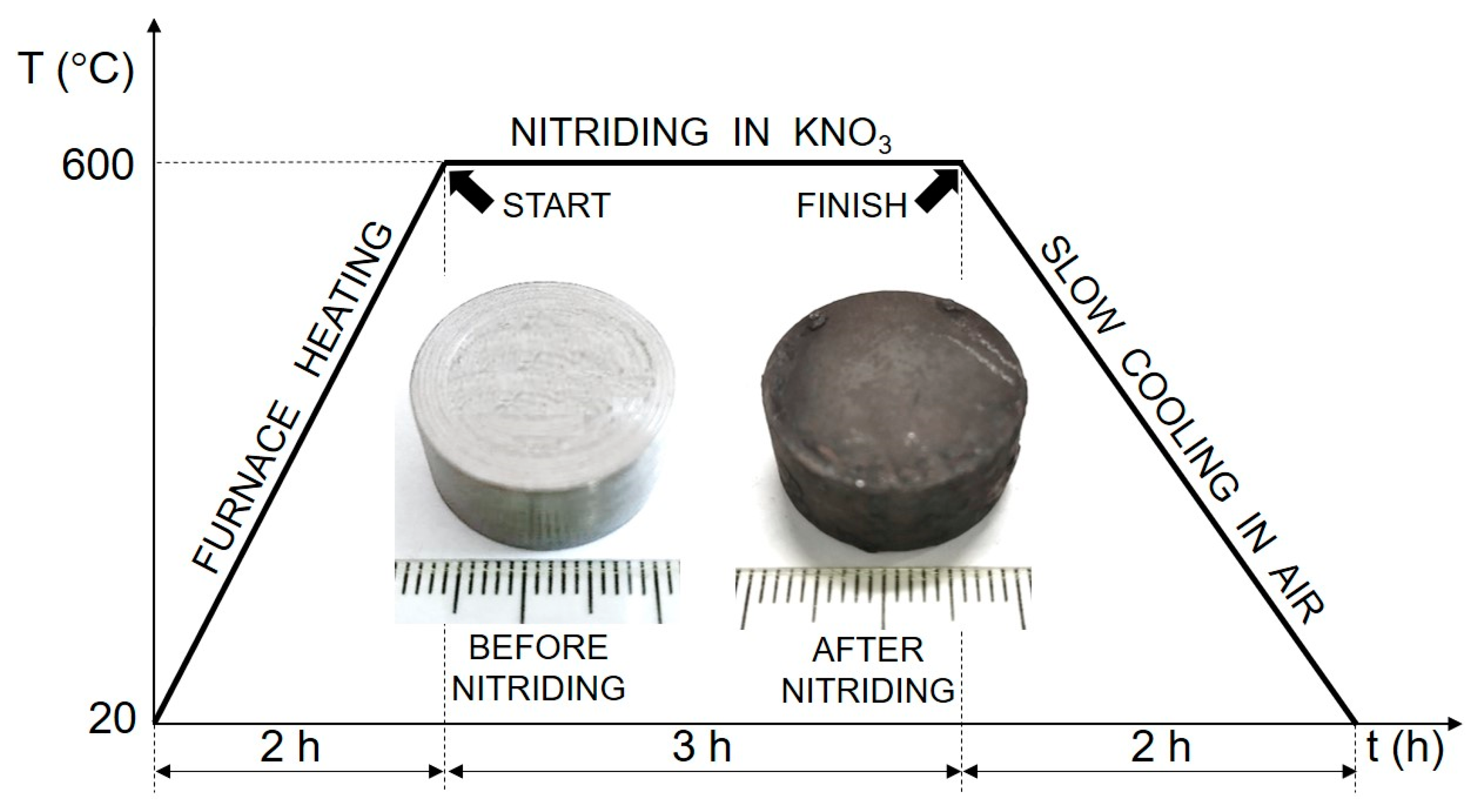
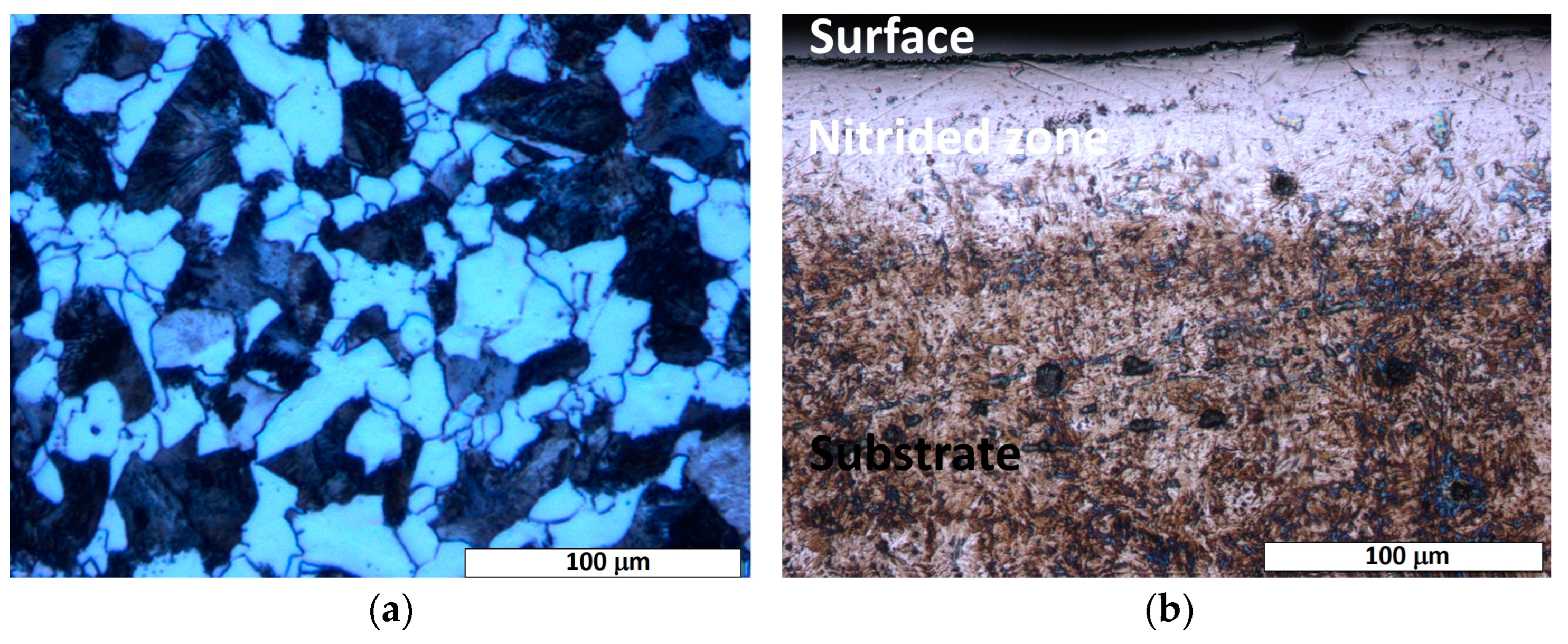
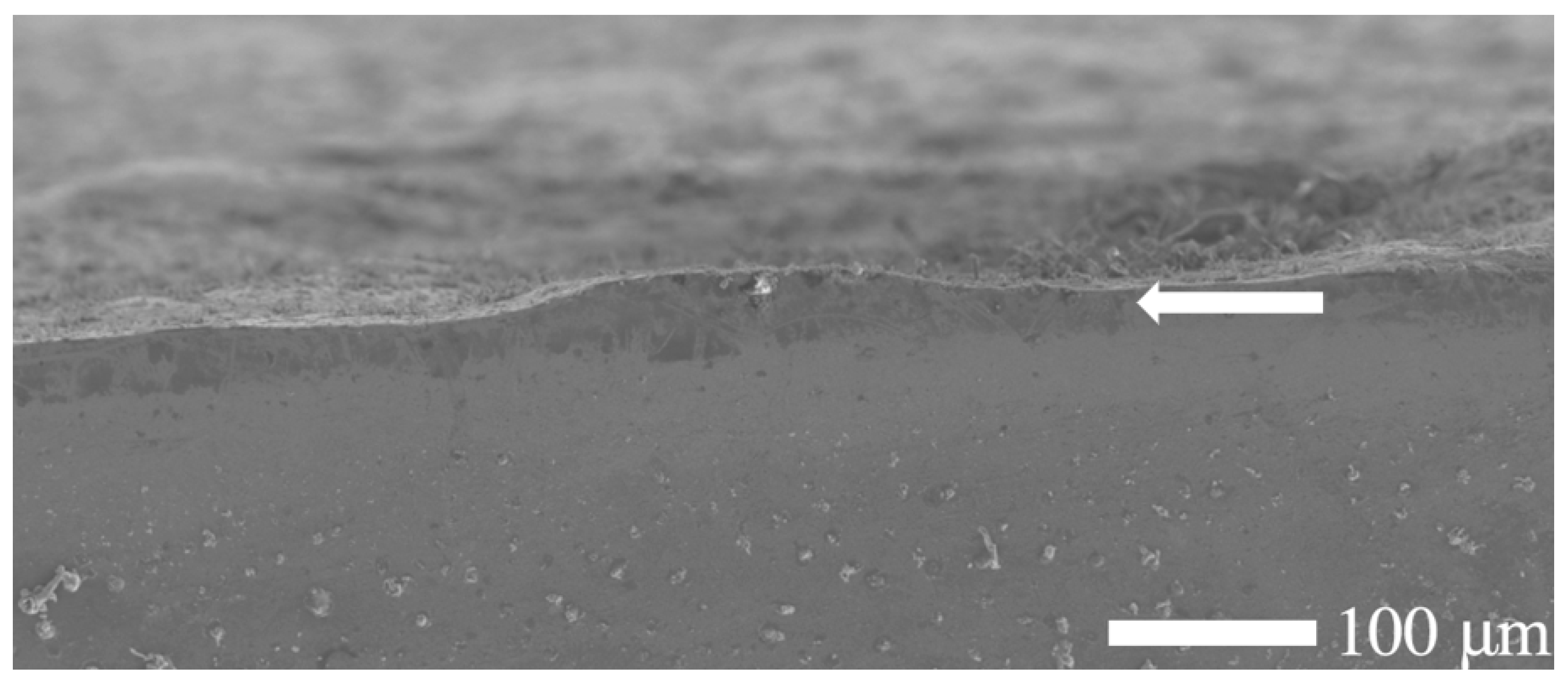

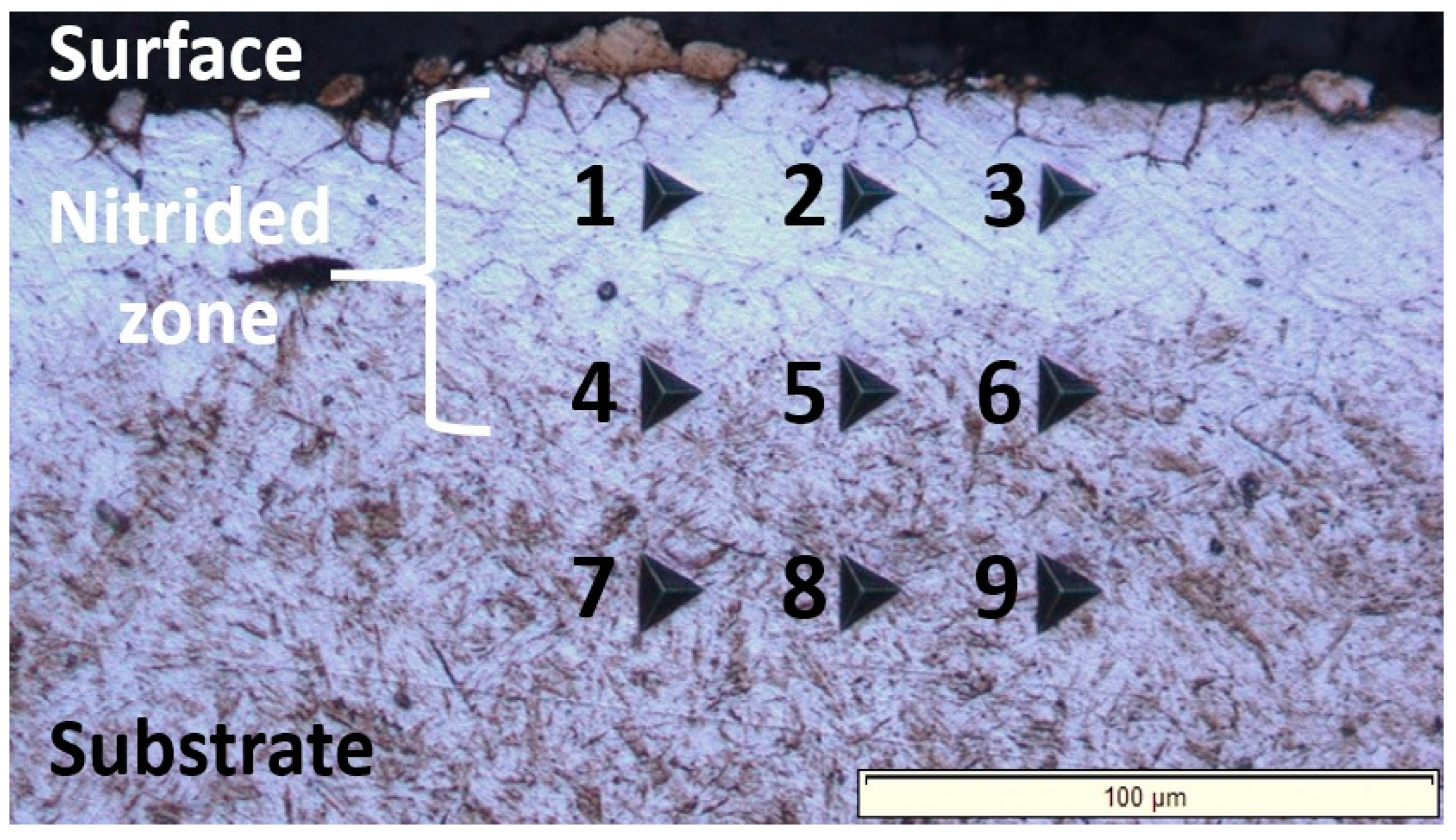
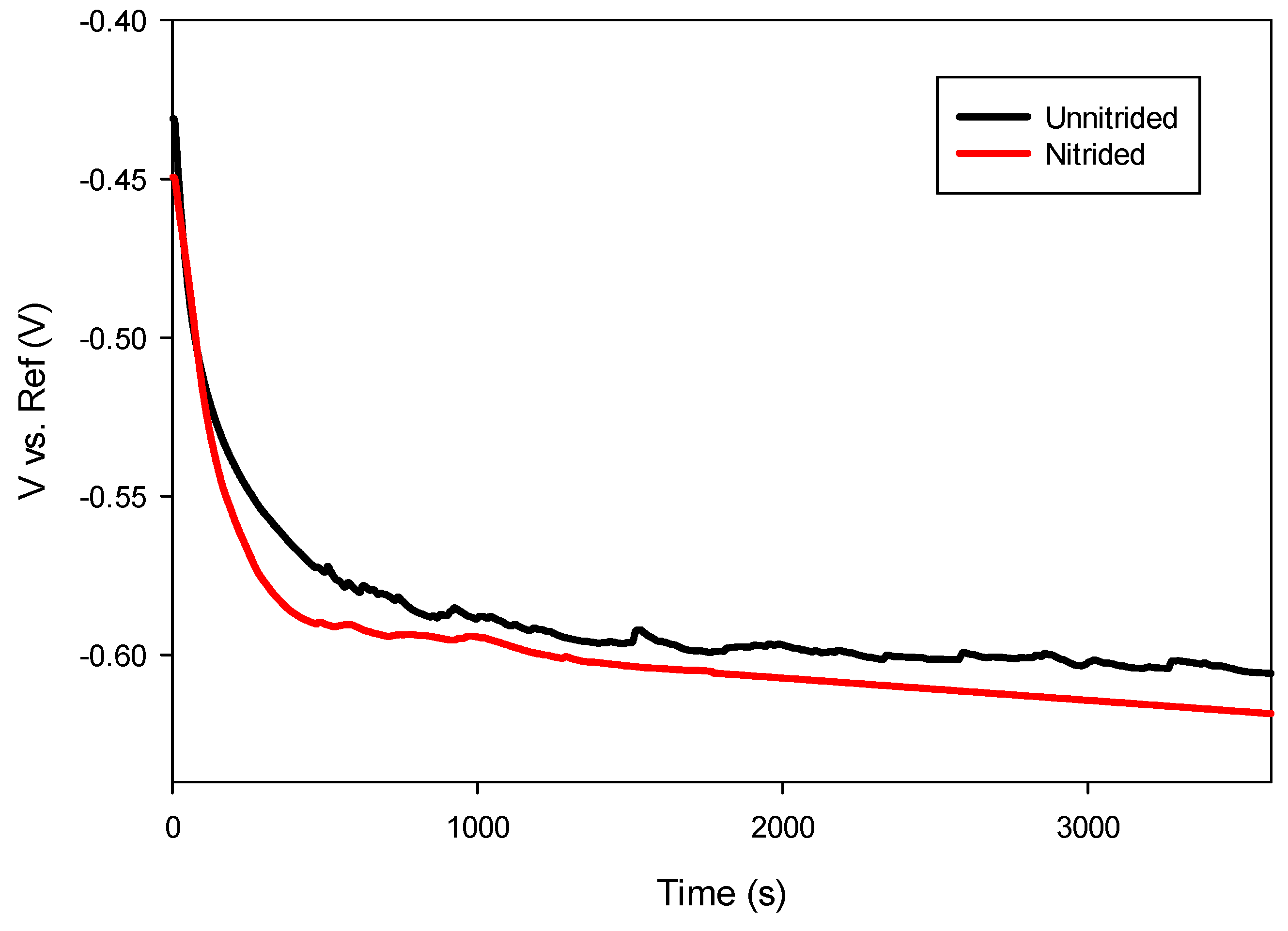


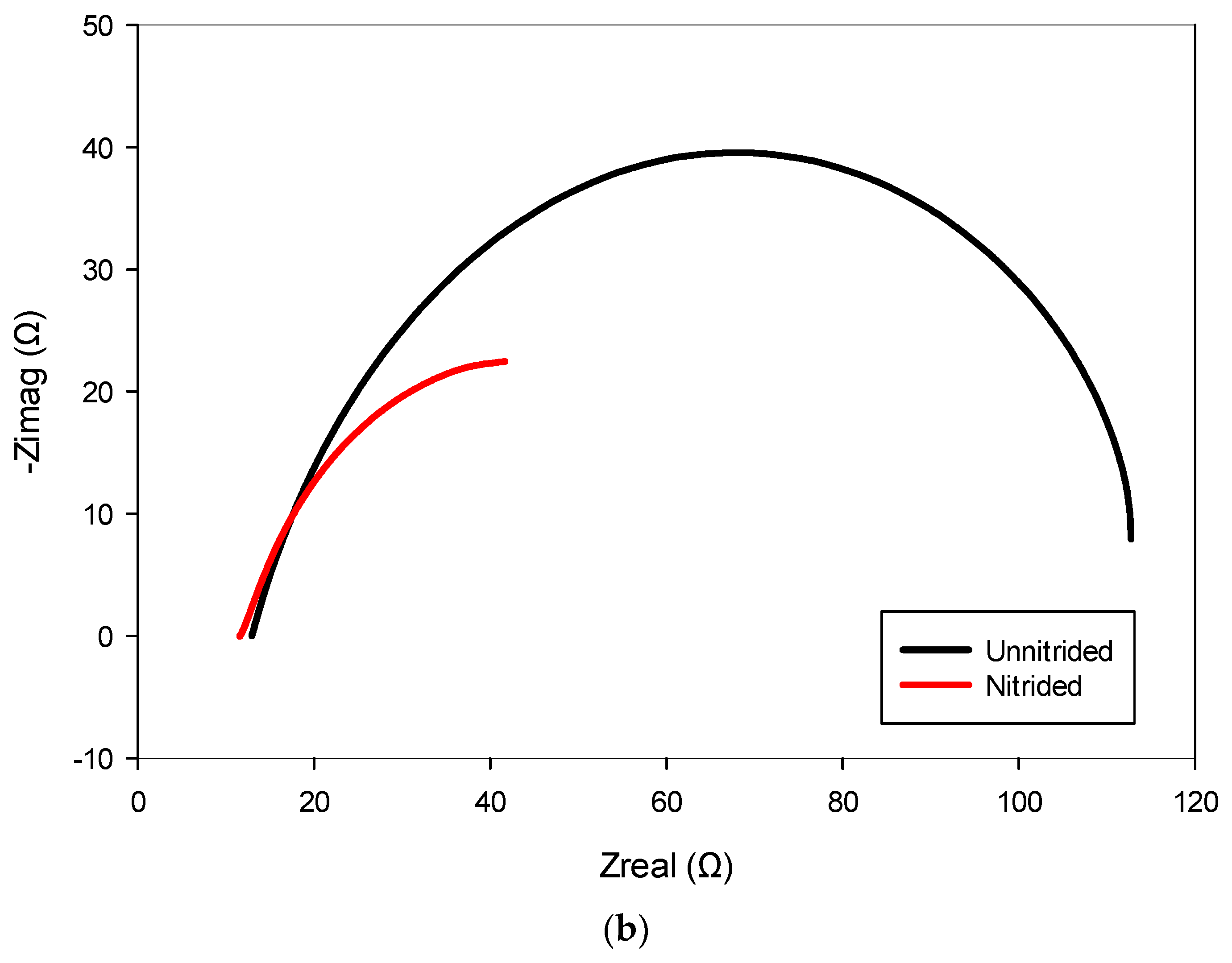
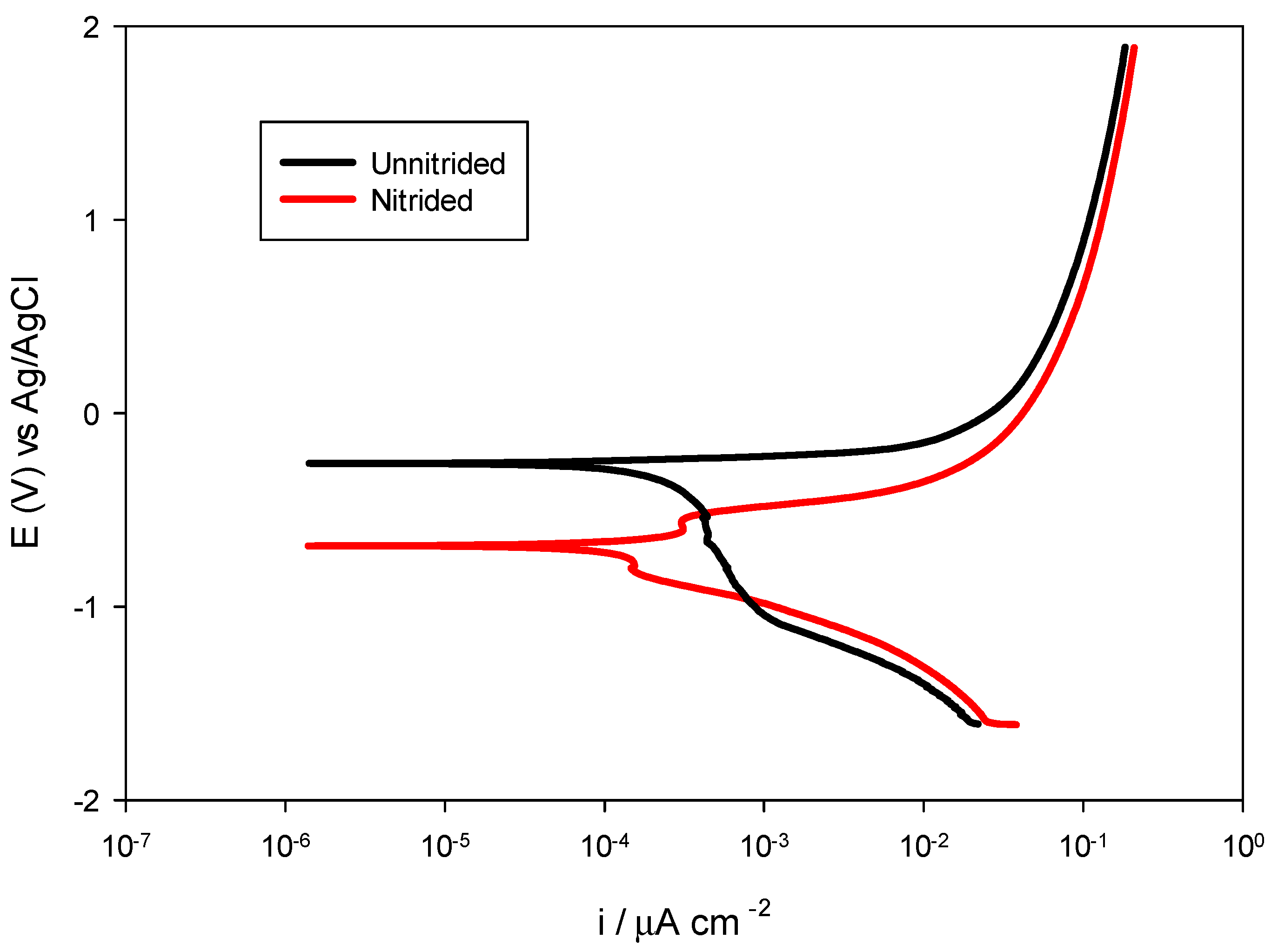
| Chemical Element | C | Si | Mn | S | Cr | Mo | Cu | Al | Ti | Fe |
|---|---|---|---|---|---|---|---|---|---|---|
| Content, wt.% | 0.22 | 0.26 | 1.01 | 0.013 | 1.0 | 0.096 | 0.17 | 0.014 | 0.027 | 97.2 |
| RSD, % | 2.72 | 1.10 | 0.40 | 4.46 | 0.44 | 5.15 | 0.61 | 3.40 | 2.71 | 1.59 |
| Bragg Reflection | Nitrided Material | Unnitrided Material | ||
|---|---|---|---|---|
| d (Å) | a (Å) | d (Å) | a (Å) | |
| (110) | 2.0155 | 2.8503 | 2.0145 | 2.8489 |
| (200) | 1.4304 | 2.8608 | 1.4285 | 2.8570 |
| (211) | 1.1694 | 2.8644 | 1.1659 | 2.8558 |
| Average lattice parameters | 2.8585 Å | 2.8539 Å | ||
| Surface | Intermediate | Substrate | |||||||
|---|---|---|---|---|---|---|---|---|---|
| Indent, location | 1 | 2 | 3 | 4 | 5 | 6 | 7 | 8 | 9 |
| Hardness, [GPa] | 10.16 | 10.24 | 9.5 | 8.44 | 7.89 | 8.5 | 7.33 | 5.67 | 6.70 |
| Young’s modulus, [GPa] | 204 | 199 | 192 | 219 | 218 | 232 | 246 | 238 | 254 |
| Sample | OCP [V] | Rp [Ω cm2] |
|---|---|---|
| Unnitraded | −0.6062 | 130.80 |
| Nitraded | −0.6184 | 76.60 |
| Specimen | Solution Resistance (Rs) [Ω] | Charge Transfer Resistance (Rct) [Ω] | CPE (Y0) [S·sn] | CPE Exponent (n) |
|---|---|---|---|---|
| Unnitraded | 12.98 | 107.6 | 9.73 × 10−4 | 0.794 |
| Nitraded | 11.67 | 70.86 | 1.50 × 10−2 | 0.747 |
| Specimen | Corrosion Potential (Ecorr) [V] | Corrosion Current Density (icorr) [μA/cm2] | Corrosion Rate [mm/year] |
|---|---|---|---|
| Unnitrided | −0.2594 | 130.3 | 3.04 |
| Nitrided | −0.6851 | 54.66 | 1.275 |
Disclaimer/Publisher’s Note: The statements, opinions and data contained in all publications are solely those of the individual author(s) and contributor(s) and not of MDPI and/or the editor(s). MDPI and/or the editor(s) disclaim responsibility for any injury to people or property resulting from any ideas, methods, instructions or products referred to in the content. |
© 2025 by the authors. Licensee MDPI, Basel, Switzerland. This article is an open access article distributed under the terms and conditions of the Creative Commons Attribution (CC BY) license (https://creativecommons.org/licenses/by/4.0/).
Share and Cite
Fonović, M.; Kvrgić, D.; Liverić, L.; Kavre Piltaver, I. Impact of KNO3-Based Salt Nitriding Treatment on the Microstructure and Corrosion Resistance of Steel 20MnCr5. Materials 2025, 18, 1857. https://doi.org/10.3390/ma18081857
Fonović M, Kvrgić D, Liverić L, Kavre Piltaver I. Impact of KNO3-Based Salt Nitriding Treatment on the Microstructure and Corrosion Resistance of Steel 20MnCr5. Materials. 2025; 18(8):1857. https://doi.org/10.3390/ma18081857
Chicago/Turabian StyleFonović, Matej, Dario Kvrgić, Lovro Liverić, and Ivna Kavre Piltaver. 2025. "Impact of KNO3-Based Salt Nitriding Treatment on the Microstructure and Corrosion Resistance of Steel 20MnCr5" Materials 18, no. 8: 1857. https://doi.org/10.3390/ma18081857
APA StyleFonović, M., Kvrgić, D., Liverić, L., & Kavre Piltaver, I. (2025). Impact of KNO3-Based Salt Nitriding Treatment on the Microstructure and Corrosion Resistance of Steel 20MnCr5. Materials, 18(8), 1857. https://doi.org/10.3390/ma18081857








